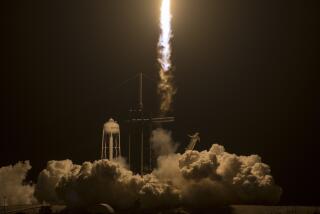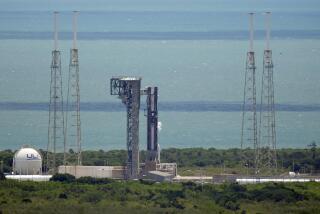Russia Raises Fears of Space Station Peril
- Share via
MOSCOW — Russia said Tuesday that it lost contact with its doomed Mir space station for nearly a day, raising fears that the 130-ton contraption will become uncontrollable when space engineers ditch it next year.
Mission Control lost touch with Mir at 6:41 p.m. Monday and reestablished the radio link about 21 hours later. Space officials were still trying to determine the cause of the communication break Tuesday night.
“Mir is under control now, and this is good,” said Gennady Bogomolov, a watch director at Mission Control. “There was a chance of us losing the station today, but thank God it did not happen.”
In two months, space officials plan to guide Mir gently to a watery grave in the middle of the Pacific Ocean. But if they can’t maintain radio contact, they will have difficulty controlling the space station’s descent.
The loss in communication was the first in Mir’s nearly 15 years in orbit, although the station has suffered a slew of other troubles, including a fire and a collision with a docking spacecraft.
“All machinery breaks down once in a while,” Bogomolov said. “Maybe this incident is yet another reminder--there is a right time for everything to come to an end.”
It wasn’t until this autumn that Russian space officials finally acknowledged that they have neither the financial nor the technical means to keep the station orbiting. Western space experts had been skeptical about Russia’s ability to keep Mir a safe and going concern while spending more time and energy on the new International Space Station. Efforts to find private donors or projects to fund Mir and keep it flying have been largely unsuccessful.
It wasn’t immediately clear Tuesday how serious an incident the communication loss was. Space officials said that, if necessary, they will send an emergency crew to the station in January to conduct repairs before Mir enters the Earth’s atmosphere and begins its final descent.
Officials say they expect that the greater part of the station will burn up on reentry into the atmosphere. But an estimated 40 tons of it might reach the Earth’s surface, and some of the chunks could weigh a ton or more.
The station has been unmanned since June, when the last regular crew bid it farewell. A total of 108 cosmonauts and astronauts, including seven Americans, have lived aboard Mir. Space shuttle crews visited it nine times.
Mir was launched in February 1986 with an expected service life of five years. Since then, crews have spent increasing amounts of time conducting repair work to keep the orbiter in working order.
The station orbits the Earth 16 times a day, and Mission Control can contact the vessel for 17 minutes during each orbit as Mir passes within Russian radio range.
Bogomolov said engineers believed an electrical short circuit might have prevented the station from responding to ground signals, but no other on-board systems appeared to have failed.
“The results of the past two radio sessions show that everything is normal on board the station and the situation on board has not changed since before the contact failure,” Bogomolov said. “The configuration of the station--in other words, what systems it is using, primary or backup--is still to be established. We do not know why exactly we were unable to contact the station.”
Mir has been slowly losing altitude since the last crew left, and it is now about 200 miles above Earth. During its final descent, engineers hope to fire thruster engines to steer the craft toward the target splashdown zone.
An unmanned cargo ship is scheduled to visit the station in January to refuel the thruster engines. But if the station’s problems persist, a standby crew of cosmonauts could take a quick trip to repair faulty equipment; a crew has been in training for just such an exigency.
“We have never lost contact with Mir before. Not once. We have had scores of other unpleasant problems, but there has never been such a grave case in which we were unable to see the orbiter for a number of hours,” Bogomolov said. “So it’s the first time. I hope it is the last too.”
In 1979, the American Skylab space station was supposed to splash down in the southern Atlantic, but pieces crashed onto remote parts of Australia. A year earlier, a Soviet satellite plunged to Earth and landed in Canada, scattering radioactive debris over a swath of wilderness. No injuries were reported in either incident.
*
Alexei V. Kuznetsov of The Times’ Moscow Bureau contributed to this report.
More to Read
Sign up for Essential California
The most important California stories and recommendations in your inbox every morning.
You may occasionally receive promotional content from the Los Angeles Times.













